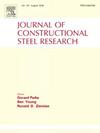Q345结构钢对焊高温冷却后的改进Johnson-Cook本构模型
IF 4
2区 工程技术
Q1 CONSTRUCTION & BUILDING TECHNOLOGY
引用次数: 0
摘要
本研究考察了Q345对焊结构钢(Q345- bw)接头在高温和不同冷却方法下的力学行为。单轴拉伸试验在温度范围从200°C到900°C的样品上进行,并通过空气,水或消防泡沫冷却。结果表明,在600℃以下,屈服强度和极限强度等力学性能基本保持稳定,而在较高温度下会发生明显的降解。随着暴露温度的升高,断口位置由热影响区向颈颈区转移,冷却方式对断口形貌和力学性能均有显著影响。提出了一种改进的Johnson-Cook本构模型,该模型能够准确地预测焊接接头火灾后的应力-应变行为。这些发现有助于更好地理解钢结构的耐火设计。本文章由计算机程序翻译,如有差异,请以英文原文为准。
Modified Johnson-Cook constitutive model for butt-welded Q345 structural steel after high temperature cooling
This study examines the mechanical behavior of butt-welded Q345 structural steel (Q345-BW) joints after exposure to elevated temperatures and subsequent cooling by different methods. Uniaxial tensile tests were performed on specimens subjected to temperatures ranging from 200 °C to 900 °C and cooled by air, water, or fire-fighting foam. The results indicate that the mechanical properties, including yield and ultimate strengths, remain largely stable below 600 °C, whereas significant degradation occurs at higher temperatures. With increasing exposure temperature, the fracture location shifts from the heat-affected zone to the necking region, and the cooling method has a pronounced influence on both fracture morphology and mechanical performance. A modified Johnson–Cook constitutive model is developed, capable of accurately predicting the stress–strain behavior of welded joints after fire exposure. These findings contribute to a better understanding of the fire-resistant design of steel structures.
求助全文
通过发布文献求助,成功后即可免费获取论文全文。
去求助
来源期刊

Journal of Constructional Steel Research
工程技术-工程:土木
CiteScore
7.90
自引率
19.50%
发文量
550
审稿时长
46 days
期刊介绍:
The Journal of Constructional Steel Research provides an international forum for the presentation and discussion of the latest developments in structural steel research and their applications. It is aimed not only at researchers but also at those likely to be most affected by research results, i.e. designers and fabricators. Original papers of a high standard dealing with all aspects of steel research including theoretical and experimental research on elements, assemblages, connection and material properties are considered for publication.
 求助内容:
求助内容: 应助结果提醒方式:
应助结果提醒方式:


